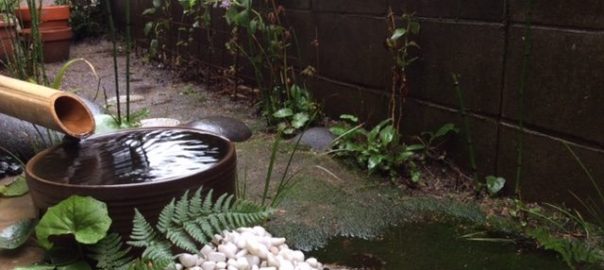“For whom do all the flowers blossom in the spring?”
—A phrase of Zen word in springtime
These days, especially in summertime, we have heavy rain in Japan. Stormwater usually goes into concrete drains and flows into rivers. Most of the land in urban areas in our country is covered with asphalt or concrete, and the water flows into rivers very quickly. This is one of the reasons for flooding in urban areas. In response, we have started to plan and design rain gardens.
I usually plan and design large-scale landscapes such as city parks, forested parks, around rivers, and so on. In this essay, I would like to think about small rain gardens. It is good for such rain gardens to be designed with both function and beauty in mind. Since I was first asked to design a Japanese garden, I started to learn “Sado”, a traditional tea ceremony, and have been doing it for 15 years because it is deeply concerned with creating a traditional Japanese garden. “Sado” is based on Zen culture; we learn not only about how to make tea, but also about native plants and flowers, calligraphy, pottery, and sometimes food. So, I tried to design a small rain garden based on Japanese traditional gardens.

An opportunity
When I moved to an old house near the sea in September 2013, I found that a roof drain had broken and the water flowed under my old house. That was not good for the house, so I fixed it, changing the flow out to a small space outside. However, it was not so beautiful to see the water coming out from the drainpipe to the small space. The small space was totally covered by weeds.

First stage
In autumn 2013, I took the weeds out (except for the native species) and dug up the soil to around 50 cm deep. Lots of stones and roots came out. I carried them away and brought small stones in, putting them in for drainage in a 20 cm. deep layer. Then, I covered them with sandy soil at 10 cm deep, covering this layer with the soil that used to be there.



When the stormwater came
After completion of the garden, we had heavy rain that fell at a rate of around 60mm/hour in the summertime of 2015. The water was absorbed into our garden, and we had no overflow, which shows me that the function of the rain garden is enough to cope with stormwater at this scale. It will be interesting to collect the rainfall data and water balance.

Vegetation and biodiversity
I covered the garden with white stones and mosses, including:
- Cameria japonica
- Ardisia japonica
- Ophiopogon japonicas
- Acer palmatum
- Miscanthus sinensis
- Farfugium japonicum
- Actinidia arguta
- Equisetum hyemale
- Tricyrtis affinis Makino
The white stones align with the water flow. I included plants and flowers that could be used for the tea ceremony. The vegetation has been changing from spring 2014 to spring 2016 bit by bit, and some small creatures came here, like bees, Plestiodon japonicus (Japanese skink), and so on. Does this mean we could find an ecological network even in this small garden?
Nature and people
An interesting aspect of Japanese traditional gardens is the plant species they include. People use endemic species for the gardens. I haven’t seen tulips in Japanese gardens. Why? The gardens try to incorporate original nature, like stones as a mountain, water as a sea and so on. People who build small gardens are trying to find the beauty of nature, and they seem to be learning nature from gardens. Although gardens are changing various ways in this country, if we think about biodiversity and local ecology, the traditional garden is sometimes a good example for me. For instance, bees come to native flowers to take their nutrients and to pollinate, meaning an interaction between insect and local plants is occurring. Traditional ways of designing are sometimes suited for endemic species.

Future issues
This is a small example of a rain garden; however, if we create this kind of small (or, if you have a big garden, that would also be good!) rain garden for each house, so that people understand the importance of it, things will change. Maintenance of the garden is one of the ways of learning Buddhism for monks; I learned lots of interesting things from the process of creating this small garden. The garden histories and backgrounds of the associated cultures are different in each country, and I think the way of creating the garden is not only functions but also dependent on each climate, vegetation, religion and so on. We can plan and design functional landscapes, but if we think more about nature and cultures, the garden will become a more interesting place.

Keitaro Ito
Kyushu












Lovely article, thank you. I am now going to Google Sado!. All the best David.
Keitaro, it is such a pleasure to see your projects, whether in a conference presentation (Berlin 2013) or here. I’m certain that your integration of the teachings and traditions of Zen lend your designs and installations great depth and resonance. It’s wonderful to see how the practical aspects you address come to poetic fruition, e.g., textures, sound, shapes, contrasts. Thanks for sharing!
Dear Grace, Thanks for your kind comments! We will think about these issues and having new great ideas in each country. It would be also important to think about biodiversity and endemic plants because of native landscape. Best wishes, Keitaro
In our community, we have a program called Mater Water Stewards. We educate ourselves and then others about storm water. We help others install gardens like this one which can manage 1 inch rains from the roofs and the hard surface areas (think driveways); the RAIN GARDENS are cupped with water hardy plants/deep roots. I love what you are doing…if everyone were to manage/filter and hold their rain water…many problems will decrease. I love your version of the idea. Best wishes.
¡Gracias! Me alegro de oír hablar de eso. ¿Tiene este tipo de jardines en su país? Cheers, Keitaro
excelente la idea de un jardin de lluvia